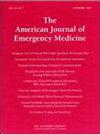Use of e-point septal separation to screen for left ventricular function in children
IF 2.2
3区 医学
Q1 EMERGENCY MEDICINE
引用次数: 0
Abstract
Objective
E-point septal separation (EPSS) is a point-of-care ultrasound measurement used to screen for left ventricular systolic dysfunction (LVSD) in adults. We evaluated the distribution of EPSS in children and determined the association between EPSS and presence/extent of LVSD.
Methods
We conducted a retrospective single-center study of pediatric echocardiograms performed between January 2019 and February 2023. Our outcome was LVSD (as mild, moderate, and severe based on ejection fraction and/or fractional shortening criteria). We evaluated the association between EPSS and LVSD and moderate-severe systolic dysfunction. We reported sensitivity, specificity and predictive values when using 7.0 mm (commonly used adult criteria) and statistically-selected EPSS thresholds.
Results
We included 770 echocardiograms; 148 had LVSD (104 mild, 32 moderate, and 12 severe). EPSS increased with increasing LVSD. The area under the receiver operator curve (AUROC) was 0.92 (95 % confidence interval [CI] 0.89–0.95) for EPSS and any LVSD and 0.94 (95 % CI 0.87–1.00) for EPSS and moderate-severe systolic dysfunction. Using a 7.0 mm threshold for any LVSD, sensitivity was 76.4 % (95 % CI 68.5–82.8 %) and specificity was 95.8 % (95 % CI 93.8–97.2 %). An optimal threshold of 6.0 mm improved sensitivity to 81.8 % (95 % CI 74.4–87.4 %). For children 0–3 years old, a threshold of 4.9 mm demonstrated better sensitivity (77.8 %, 95 % CI 51.9–92.6 %) compared to the 7.0 mm threshold (55.6 %, 95 % CI 31.3–77.6 %). For children >3 years old, the 7.0 mm and optimal thresholds performed similarly for moderate-severe systolic dysfunction.
Conclusions
EPSS is a promising screening technique for pediatric LVSD. The 7.0 mm threshold may be an adequate screen for older children.
使用e点间隔分离筛查儿童左心室功能。
目的:e点间隔分离(EPSS)是一种用于筛查成人左心室收缩功能障碍(LVSD)的即时超声测量方法。我们评估了EPSS在儿童中的分布,并确定了EPSS与LVSD存在/程度之间的关系。方法:我们对2019年1月至2023年2月期间进行的儿童超声心动图进行了回顾性单中心研究。我们的结果是LVSD(根据射血分数和/或分数缩短标准分为轻度、中度和重度)。我们评估了EPSS与LVSD和中重度收缩功能障碍之间的关系。我们报告了使用7.0 mm(常用的成人标准)和统计选择的EPSS阈值时的敏感性、特异性和预测值。结果:我们纳入了770张超声心动图;148例LVSD(轻度104例,中度32例,重度12例)。EPSS随LVSD升高而升高。EPSS和任何LVSD的受试者操作曲线下面积(AUROC)为0.92(95%可信区间[CI] 0.89-0.95), EPSS和中重度收缩功能障碍的受试者操作曲线下面积(AUROC)为0.94 (95% CI 0.87-1.00)。使用7.0 mm阈值诊断LVSD,敏感性为76.4% (95% CI 68.5- 82.8%),特异性为95.8% (95% CI 93.8- 97.2%)。6.0 mm的最佳阈值将灵敏度提高到81.8% (95% CI 74.4- 87.4%)。对于0-3岁的儿童,与7.0 mm阈值(55.6%,95% CI 31.3- 77.6%)相比,4.9 mm阈值表现出更好的敏感性(77.8%,95% CI 51.9- 92.6%)。对于bb0 ~ 3岁的儿童,7.0 mm和最佳阈值对于中重度收缩功能障碍的表现相似。结论:EPSS是一种很有前途的儿童LVSD筛查技术。对于年龄较大的儿童,7.0毫米的阈值可能是足够的。
本文章由计算机程序翻译,如有差异,请以英文原文为准。
求助全文
约1分钟内获得全文
求助全文
来源期刊
CiteScore
6.00
自引率
5.60%
发文量
730
审稿时长
42 days
期刊介绍:
A distinctive blend of practicality and scholarliness makes the American Journal of Emergency Medicine a key source for information on emergency medical care. Covering all activities concerned with emergency medicine, it is the journal to turn to for information to help increase the ability to understand, recognize and treat emergency conditions. Issues contain clinical articles, case reports, review articles, editorials, international notes, book reviews and more.

 求助内容:
求助内容: 应助结果提醒方式:
应助结果提醒方式:


